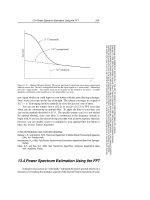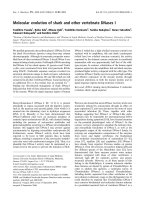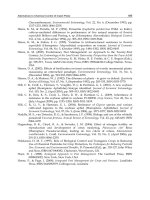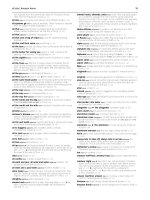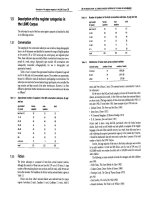Cultivation of soya and other legumes - Part 5 pptx
Bạn đang xem bản rút gọn của tài liệu. Xem và tải ngay bản đầy đủ của tài liệu tại đây (229.17 KB, 11 trang )
Introducing soya at the local level 59
9 Introducing soya at the local level
Introducing new foods into an area is not always easy. People eat what
they are accustomed to, which is often determined by local traditions
and these are difficult to change. New foods are often first greeted
with suspicion. For this reason it is important to emphasize the good
qualities of soya and in particular its high nutritional value.
A good way to introduce soya is to offer it along with the usual food
of an area, for example in the form of a snack or drink. Then it is per-
haps worth mixing some soya beans into a vegetable sauce for people
to try. In many parts of the world people eat beans that have been
mashed (e.g. refried beans in South America and Mexico). Soya beans
could be added to these dishes. Refried bean dishes are often heavily
spiced, which also makes the soya tasty.
A good way to introduce soya into an area is through women’s groups.
Discovering a new crop and food together encourages people to ex-
change their findings and experiences with each other, and to ex-
change recipes. In this way women can learn to make new meals and
soya products that can be sold. These products can provide a new way
of earning income, to help increase food security. In Ghana there are
women’s groups that are actively working with the introduction of
soya. They cultivate the soya together and work out ways of preparing
soya products and look for ways of selling them on the local markets.
It is not always women who cultivate soya everywhere. In some
places it is the men who grow the soya. They could start by cultivating
small test plots to see which crop has the best yield. The information
in the first chapters of this book is useful for these experiments.
The introduction of a new food requires time and patience. But if you
are creative and persist you will be able to convince many people that
soya not only enriches their farming system, but also their daily diet.
By setting a positive example locally you will win over people in the
area. Your enthusiasm will spread and with it the news and informa-
tion about the new crop.
Cultivation of soya and other legumes 60
Appendix 1: Legumes
Table 10: Growing conditions for food legumes.
English
name
Scientific
name
Climate/water
requirements
Tem-
perature
Soil
groundnut,
peanut
Arachis hy-
pogaea
250-650 mm in 3-4
months or 650-1300
mm in 4-5 months;
cannot tolerate too
much water
20°-35°C Light sandy soil with suffi-
cient nutrients for beans
which grow under the
ground
pigeon pea,
congo pea,
red gram
Cajanus
cajan
800-1000 mm 20°-40°C Only legumes on this list
that can tolerate slightly
saline (salty) soils
chickpea,
gram pea
Cicer arieti-
num
Demanding in terms of
requirements: sufficient
water during vegetative
growth; will not tolerate
heavy rainfall during
flowering period
15°-30°C Grows on light and heav-
ier soils that are well
drained. Requires a pH of
6-9, cannot tolerate saline
or acid soils
soybean,
soya bean
Glycine max
700-1000 mm 20°-30°C Grows well on heavier
soils that are well drained.
Cannot tolerate saline or
alkaline soils
butterbean,
hyacinth
bean
Lablab pur-
pureus
600-900 mm drought
resistant, better than
soya or Phaseolus sp.
lentil, gram
Lens culinaris
800-2000 mm 20°-30°C
butterbean,
lima bean
Phaseolus
lunatus
700-1000 mm
garden bean,
kidney bean,
haricot,
common
bean
Phaseolus
vulgaris
700-1000 mm; cannot
tolerate too much water
10°-30°C Loamy soil, reasonably
fertile, pH 5.0-7.5 crumbly
soil structure important for
a good yield.
pea
Pisumar-
vense and
pisum sati-
vum
500-800 mm 10°-30°C
survives
below
freezing
point
PH 5.5-6.8, can tolerate
somewhat saline soils.
Requires a well-prepared
soil with crumbly structure
and good drainage.
cowpea,
blackeyed
pea
Vigna ungui-
culata syn.
Vigna sinen-
sis syn. Vigna
sesquipedalis
600-900 mm 20°-35°C
bambara
groundnut
Vigna subter-
ranea syn.
Voandzeia
subteranea
Dry, Sahel; cannot
tolerate too much water
Light sandy soil with suffi-
cient nutrients, because
beans grow underground
Appendix 1: Legumes 61
Table 11: Sowing distances and densities
English
name
Scientific name Sowing density (cm x cm) Sowing density (kg
grain/ ha)
groundnut,
peanut
Arachis hypogaea
30 x 30 hand cultivated 60-40
x 15 cultivated using animal
traction
50-80
pigeon pea,
congo pea,
red gram
Cajanus cajan
60-40 x 30-45; 180 x 150
Puerto Rico; 150 x 150 East
Africa; 90 x 60 Sri Lanka
13-22 India; 9 Sri
Lanka
chickpea,
gram pea
Cicer arietinum
30-60 x 10
soybean,
soya bean
Glycine max
60 x 5; 50 x 2-3 cultivated
using machine
55-65 Asia 22- 34
Africa
butterbean,
hyacinth bean
Lablab purpureus
80 x 10; 80 x 20 Sudan 55-65 Asia 22-34
Africa
butterbean,
lima bean
Phaseolus lunatus
75-60 x 10-15 cultivars with big
bean 75-60 x 7.5-12.5 cultivars
with small bean
36-78 small beans,
130-170 big beans
garden bean,
kidney bean,
haricot bean,
common
bean
Phaseolus vulgaris
90-5- x 22-5; double rows 60
spaced out and 15- 30 in the
double rows; the climbers need
support such as canes.
30; 45; 55; 70; 90;
115
pea
Pisum arvense
and Pisum sativum
Dwarf cultivars 18 - 25 x 5,
semi-dwarf cultivars 30-65 x 5,
Many- branched cultivars 100
x 5
80
cowpea,
blackeyed
pea
Vigna unguiculata
syn. Vigna sinen-
sis syn. Vigna
sesquipedalis
90 x 30; 45 x 15; 50 x 50; 50 x
40
22; 33
yard bean
Vigna unguiculata
ssp sesquipedalis
syn. Vigna sesqui-
pedalis
100 x 30-50 support necessary
(canes or wires)
25- 50
bambara
groundnut
Vigna subterranea
syn. Voandzeia
subteranea
45 x 10-15; 2 rows on ridges
90 cm apart
35; 50; 65
Cultivation of soya and other legumes 62
Appendix 2: Inoculating soya with
rhizobium
If the soya plant does not form active root nodules on its own then the
crops needs treating or inoculating with rhizobium. It is not always
easy to find rhizobium. In countries where rhizobium has been used
for a long time it will be easy to find rhizobium products through the
agricultural extension services. In other places it may be necessary to
contact agricultural research stations in your own country or
neighbouring countries.
Inoculation methods
There are two ways of carrying out inoculation
? Inoculating the seed material with rhizobium before sowing it.
? Inoculating the soil with rhizobium in the field where soya is to be
sown.
Generally speaking the first method is preferred because it is simpler
to carry out and is far cheaper to do.
However, sometimes it is necessary to inoculate the soil; for example
if the soil is very dry and acid (pH < 5), or contains many rhizobia that
do not create active root nodules, or if the soya has been treated with a
chemical such as a fungicide or insecticide which rhizobia cannot tol-
erate. Because it is not yet known which chemicals rhizobia can toler-
ate, it is better to assume that inoculating any soya seed that has been
treated with fungicides or pesticides will not help root nodule forma-
tion. In these cases it is better to inoculate the soil.
Inoculating seed
Rhizobium bacteria comes in powdered form, called inoculant. It has
to be mixed with water until you have a mixture you can pour (slurry).
Appendix 2: Inoculating soya with rhizobium 63
Figure 22: Inoculating seed.
Cultivation of soya and other legumes 64
This is the most commonly used method throughout the world. Bo-
livia has been producing inoculant on a commercial scale since 1991
with very good results. If you add some sugar to the slurry mixture the
rhizobium bacteria die less quickly during the drying. It is important
that the seed does not get too wet, so that it does not stick together or
get damaged by the sowing machine.
The following quantities are recommended for soya: 25 kg seed, 250
ml water and 110 g rhizobium powder. Adjust these quantities for the
amount of seed you are using. If necessary make a table of quantities
for yourself.
Sometimes the powder is added dry to the seed in the sowing ma-
chine. This is not advisable because the powder blows away easily and
so is lost.
Inoculation of seeds only works if it is done just before they are sown.
Preinoculated seed sold in shops usually gives disappointing results
and we do not advise you to use it.
How often should I inoculate?
The advice given in Bolivia is to assume that there will not be suffi-
cient rhizobia present in the soil of fields where soya has been grown
for longer than five years. Even better is to always inoculate your
seed. In Bolivia this is considered a ‘cheap form of insurance’.
Inoculating the soil
Fluid mixtures
Inoculating soya beans in Senegal gave good results with 5 litres per
hectare of a solution of 2 parts powder and 1 part water. The solution
was sprayed on to the soil.
Granules
Porous granules can be treated with rhizobium and mixed with the
seed in the sowing machine or spread by special machines that spread
Appendix 2: Inoculating soya with rhizobium 65
insecticide in the form of granules along the rows. In this case 6 – 8 kg
of inoculant can be sufficient. We do not have details of how much
rhizobium this kind of inoculant contains.
When buying inoculant you should check that the following things are
listed on the packaging:
? The scientific (Latin) name of the rhizobium (for soya this is R. ja-
ponica).
? Instructions for use.
? How to store the product; not above 40°C because the rhizobium
will die. At a temperature of about 20°C inoculant will remain good
for about 6 months. At 4°C it will last even longer.
? The shelf life of the product must be given: the date after which the
product can no longer be used.
Cultivation of soya and other legumes 66
Appendix 3: Giving advice on
inoculation
You can carry out a simple comparative trial to convince farmers that
inoculation is worthwhile. The soya plants are treated in three differ-
ent ways.
1 inoculation with the best inoculant available in the area.
2 no inoculation and no artificial fertilizer given.
3 only artificial fertilizer applied (if this is advised in the area).
For each treatment a plot is prepared with spacing of 60 cm between
the rows and 3.5 cm within the rows. Each plot should have at least 4
rows. This means that the plot will 2.4 x 2.4 m.
Each plot looks like the one below:
Figure 23: One treatment plot
Each treatment is repeated 3 times in order to exclude the possibility
of coincidence. Each trial is therefore carried out 3 times. A total of 3
plots for each of the 3 treatments means a total of 9 plots.
Appendix 3: Giving advice on inoculation 67
With paths of 0.5 m between the plots the whole trial field will look
like this:
Figure 24: The trial field
Calculating further for 450,000 plants per hectare:
With a seed weight of 9000 seeds/ kg, 65 kg seed/ ha is required with
286 g inoculant.
Only the middle two rows of each plot are compared with each other,
because the treatment at the edges may be influenced by the treatment
on the other plots.
Cultivation of soya and other legumes 68
Further reading
Cultivation of soya
ACIAR Proceedings no 18. Food Legume Improvement for Asian
Farming Systems, Proceedings of an international workshop held in
Khon Kaen, Thailand, 1-5 September 1986 (editors Wallis, E.S. and
Byth, D.E.) ISBN: 0949511-28-5.
Deutsche Gesellschaft für Technische Zusammenarbeit (GTZ), Multi-
lingual illustrated dictionary. 1992. ISBN: 3-8236-1126-7.
Dupriez, H., De Leener, P., Land and Life, Agriculture in African
Rural Communities, Crops and Soils. 1988, Macmillan Publishers
in association with Terres et Vie and CTA.
Food and Agricultural Organization of the United Nations (FAO), Le-
guminous Inoculants and their use. 1984, A pocket manual jointly
prepared by Nitrogen Fixation for Tropical Agricultural Legumes
(NifTAL) Project USA and FAO Fertilizer and Plant Nutrition Service.
Food and Agricultural Organization of the United Nations (FAO),
Tropical Soybean, Improvement and production. 1994, Plant Pro-
duction and Protection Series, Brazilian Agricultural Enterprise, Na-
tional Soybean Research Centre (EMBRAPA-CNPSo).
ICARDA, Winter Cereals and Food Legumes in Mountainous Ar-
eas. 1988, International Centre for Agricultural Research in the Dry
Areas (ICARDA).
Meneses, R., Waaijenberg, H., Piérola, L. (editors), Las leguminosas
en la Agricultura Boliviana Revision de Información. 1996, Cocha-
bamba, Bolivia.
Johansen, C. et al. (editors), Legumes in Rice and Wheat Cropping
Systems on the Indo-Gangetic Plain – Constraints and Opportuni-
ties. 2000, International Crops Research Institute for the Semi-Arid
Tropics.
Further reading 69
Oram, P. and Abderrezak, B., Legumes in Farming Systems. 1990,
ICARDA/ IFPRI Report.
Pandey, R.K., A farmer’s primer on growing soybean on riceland.
1987, IRRI AND IITA.
Sinha, S.K., Food legumes: distribution, adaptability and biology
of yield. 1977, Food and Agricultural Organization of the United Na-
tions (FAO), Rome. ISBN: 92-5-100186-3.
Stanton, W.R., Grain legumes in Africa. 1966, 183 pp., Food and Ag-
ricultural Organization of the United Nations (FAO), Rome, Italy.
Summerfield, R.J., Roberts, E.H. (editors), Grain Legume Crops.
1985, Collins. ISBN: 245547-03.
Nutrition and recipes
Food and Agricultural Organization of the United Nations (FAO),
Utilization of tropical foods: tropical oil seeds. 1989, FAO Food and
nutrition paper 47/5.
Food and Agricultural Organization of the United Nations (FAO),
Technology of production of edible flours and protein products
from soybeans. 1992, FAO service bulletin 97, FAO.
NEVO, Dutch Nutrient Database. 1996, Stichting Nederlands Voed-
ingsstoffenbestand, Zeist, The Netherlands.
Schempp, R., How can I cook soyabean? 1989, Recipe book pro-
duced by the United Church of Zambia.
Thio Goan Loo, Small-scale processing of soybeans and some ap-
plications. 1971, Royal Tropical Institute, Amsterdam, The Nether-
lands.
